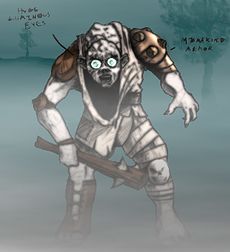The official GemStone IV encyclopedia.
The carceris makes a peculiar rustling sound as she moves, reminiscent of dried up parchment. Ragged robes lift and swirl about her like animated tendrils, and bare bones protrude from similar tatters of skin hanging from her hands and hollow cheeks. The specter bares yellowed teeth, the roots discolored a deep brown where they are anchored in the visible jawbones. As she circles, constantly whispering a litany of magic, gooey pools of darkness which were once the horror's eyes weep rivulets of stain down the remnants of her face.
Hunting strategies
- Sorcerer Tactics:
- Use Corrupt Essence (703) to keep them from casting. TD pushdown is very useful especially when combined with Voln approach below.
- Stun easily and easy criticals with Mana Disrupt (702)
- Energy Maelstrom (710) can be utilized well in focused form to induce roundtime from knockdowns, death crits and stuns. "Fire and forget" nature of storm rounds also allows for Corrupt Essence (703) to be more easily maintained for defense.
- Voln Addendum:
Other information
This section has not been added yet; please add to it now!
Behind The Scenes
Carceris translates as "prisoner" in Latin. The name might also refer to the mythical fortress of Caer Sidi from the Middle Welsh poems in the Book of Taliesin, which addresses "Annwn", the Welsh word or the Celtic Otherworld which was on an island of magical mists and filled with demons. The stories of Annwn are precursors of Arthurian legend involving Excalibur and the Holy Grail. The poem of Caer Sidi refers to Annwn by the names of several different fortresses and the "gate of the cold place", where Castle Anwyn is unnaturally cold in most of its rooms.
Caer Sidi is referenced elsewhere by Taliesin: "Perfect is my chair in Caer Sidi: Plague and age hurt not him who's in it." This may be alluded to by the hidden throne of bones, with the severed head on the pike referring to Bran the Blessed (also spelled as Vran meaning crow or raven and possibly related to the keeper of the Grail), whose head was severed and continued to speak in a land where time did not pass, following a war with King Math involving a magical cauldron (the precursor of the grail) kept bubbling by nine pythonesses that brought the dead to life.
The chair is more directly an allusion to the Siege Perilous belonging to the Grail Knight, the anointed successor of Joseph of Arimathea and thus future Grail King. Originally, this was Sir Gawain who in one story has a shield with a pentangle on it, the Seal of Solomon intended to thwart demonic forces. The mangled shields the carceris carry probably refer to Gawain having a broken shield at one point in some stories. The honor guard of heads on pikes refers narrowly to knights sitting in the chair who were not "Chosen", but may refer to the bleeding lance whose nature Gawain asks about causing partial restoration of the lands, and the Welsh version of Perceval story treats the Grail as a dish with a severed head. This represents a purely non-Christian version of the Grail, rooted in a vengeance story rather than a cup of the Last Supper as with Galahad.
Castle Anwyn was where Terate grew up as a prince, was driven mad with a Vvrael related scroll, and was one of the places where a Stone of Virtue was discovered. It has many examples of writhing serpent imagery within it, and is located on an island in foggy Lough Ne'halin, which translates roughly as "lake without salt." The motivation for "prisoner" is likely using the subtle word play regarding the etymology of the keep and dungeon, where the whole site is apparently based on St. Patrick's Purgatory in Lough Derg, with a cave underneath what is called the Prison Chapel. This was connected to the Chapel Perilous in the work of Jessie Weston, which is represented by chapel and crypt of the castle. There is also a version where Gawain is the knight who harrows Purgatory with Merlin and Arthur, whereas usually the descent into purgatory is associated with the knight Owain. In the year after the Vvrael saga ended there was a situation where the scroll was found causing its reader Norandar to physically transform, and the queen unleashed demons on adventurers. They were intervened upon by Onar, who was the kingdom's patron deity.
References
| Near-level creatures - edit
|
|
|
